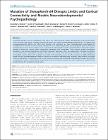| dc.contributor.author | GILL, MICHAEL | en |
| dc.contributor.author | MORRIS, DEREK | en |
| dc.contributor.author | CORVIN, AIDEN | en |
| dc.contributor.author | MITCHELL, KEVIN | en |
| dc.date.accessioned | 2011-12-15T11:51:48Z | |
| dc.date.available | 2011-12-15T11:51:48Z | |
| dc.date.issued | 2011 | en |
| dc.date.submitted | 2011 | en |
| dc.identifier.citation | Annette E. Rünker, Colm O'Tuathaigh, Mark Dunleavy,Derek W. Morris, Graham E. Little, Aiden P. Corvin,Michael Gill, David C. Henshall, John L. Waddington, Kevin J. Mitchell, Mutation of Semaphorin-6A Disrupts Limbic and Cortical Connectivity and Models Neurodevelopmental Psychopathology, PLoS ONE, 6, 11,, 2011, e26488 | en |
| dc.identifier.other | Y | en |
| dc.identifier.uri | http://hdl.handle.net/2262/61287 | |
| dc.description | PUBLISHED | en |
| dc.description.abstract | Psychiatric disorders such as schizophrenia and autism are characterised by cellular disorganisation and dysconnectivity across the brain and can be caused by mutations in genes that control neurodevelopmental processes. To examine how neurodevelopmental defects can affect brain function and behaviour, we have comprehensively investigated the consequences of mutation of one such gene, Semaphorin-6A, on cellular organisation, axonal projection patterns, behaviour and physiology in mice. These analyses reveal a spectrum of widespread but subtle anatomical defects in Sema6A mutants, notably in limbic and cortical cellular organisation, lamination and connectivity. These mutants display concomitant alterations in the electroencephalogram and hyper-exploratory behaviour, which are characteristic of models of psychosis and reversible by the antipsychotic clozapine. They also show altered social interaction and deficits in object recognition and working memory. Mice with mutations in Sema6A or the interacting genes may thus represent a highly informative model for how neurodevelopmental defects can lead to anatomical dysconnectivity, resulting, either directly or through reactive mechanisms, in dysfunction at the level of neuronal networks with associated behavioural phenotypes of relevance to psychiatric disorders. The biological data presented here also make these genes plausible candidates to explain human linkage findings for schizophrenia and autism. | en |
| dc.description.sponsorship | his work was supported by grants from Science Foundation Ireland to KJM (01/F1/B006; 07/IN.1/B969, 09/IN.1/B2614), JLW (07/IN.1/B960), DCH (08/IN1/B1875), and DWM (07/RFP/GENF327), and from the Health Research Board to KJM (RP/2007/207) and DCH (RP/2007/37). AER was supported by a postdoctoral fellowship from the Health Research Board (PD/2004/16). CO was supported by a postdoctoral fellowship from the Health Research Board (PD/2007/20). GEL has been supported by a Government of Ireland Scholarship, awarded by the Irish Research Council of Science, Engineering and Technology. The funders had no role in study design, data collection and analysis, decision to publish, or preparation of the manuscript. | en |
| dc.format.extent | e26488 | en |
| dc.language.iso | en | en |
| dc.relation.ispartofseries | PLoS ONE | en |
| dc.relation.ispartofseries | 6 | en |
| dc.relation.ispartofseries | 11, | en |
| dc.rights | Y | en |
| dc.subject | Neuroscience | en |
| dc.subject | schizophrenia | en |
| dc.subject | autism | en |
| dc.title | Mutation of Semaphorin-6A Disrupts Limbic and Cortical Connectivity and Models Neurodevelopmental Psychopathology | en |
| dc.type | Journal Article | en |
| dc.type.supercollection | scholarly_publications | en |
| dc.type.supercollection | refereed_publications | en |
| dc.identifier.peoplefinderurl | http://people.tcd.ie/mgill | en |
| dc.identifier.peoplefinderurl | http://people.tcd.ie/morrisdw | en |
| dc.identifier.peoplefinderurl | http://people.tcd.ie/kemitche | en |
| dc.identifier.peoplefinderurl | http://people.tcd.ie/acorvin | en |
| dc.identifier.rssinternalid | 76297 | en |
| dc.subject.TCDTheme | Genes & Society | en |
| dc.subject.TCDTheme | Neuroscience | en |
| dc.identifier.rssuri | http://dx.doi.org/10.1371/journal.pone.0026488 | en |
| dc.contributor.sponsor | Health Research Board (HRB) | en |
| dc.contributor.sponsorGrantNumber | RP/2007/37 | en |
| dc.contributor.sponsor | Health Research Board (HRB) | en |
| dc.contributor.sponsorGrantNumber | RP/2007/207 | en |
| dc.contributor.sponsor | Health Research Board (HRB) | en |
| dc.contributor.sponsorGrantNumber | PD/2007/20 | en |
| dc.contributor.sponsor | Health Research Board (HRB) | en |
| dc.contributor.sponsorGrantNumber | PD/2004/16 | en |
| dc.contributor.sponsor | Science Foundation Ireland (SFI) | en |
| dc.contributor.sponsorGrantNumber | 09/IN.1/B2614 | en |
| dc.contributor.sponsor | Science Foundation Ireland (SFI) | en |
| dc.contributor.sponsorGrantNumber | 08/IN1/B1875 | en |
| dc.contributor.sponsor | Science Foundation Ireland (SFI) | en |
| dc.contributor.sponsorGrantNumber | 07/RFP/GENF327 | en |
| dc.contributor.sponsor | Science Foundation Ireland (SFI) | en |
| dc.contributor.sponsorGrantNumber | 07/IN.1/B969 | en |
| dc.contributor.sponsor | Science Foundation Ireland (SFI) | en |
| dc.contributor.sponsorGrantNumber | 07/IN.1/B960 | en |
| dc.contributor.sponsor | Science Foundation Ireland (SFI) | en |
| dc.contributor.sponsorGrantNumber | 01/F1/B006 | en |




